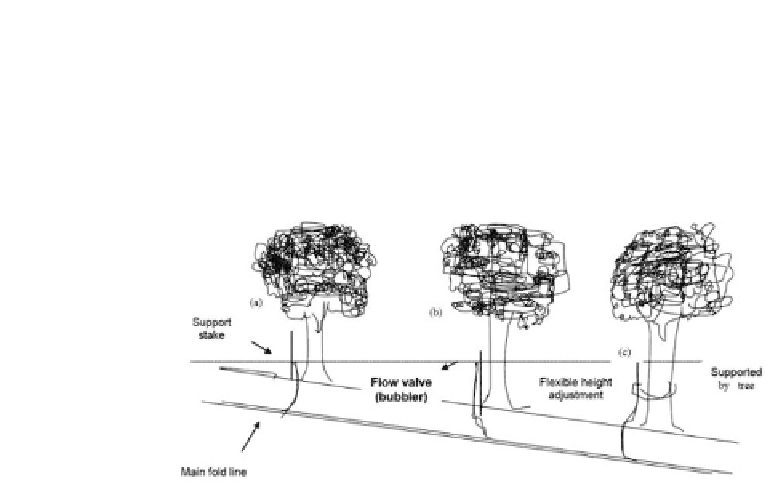Agriculture Reference
In-Depth Information
technical know-how. James [44] indicated several problems associated with drip ir-
rigation, such as, emitter clogging which can cause poor uniformity of water applica-
tion. He added that a special equipment was needed to control clogging; and the size of
pipes, emitters type, valves type, etc., in drip system often contributes to high cost per
ha cost compared to solid-set sprinkler system).
FIGURE 1
Typical diagram of low-head bubbler irrigation system [33].
20.1.1.2 LOW-HEAD BUBBLER IRRIGATION
Behoteguy and Thornton [12] defined the bubbler system as a type of drip irriga-
tion that typically delivers flow rates of 2 to 4 L per minute through a small di-
ameter of polyethylene (P.E) delivery tube attached to a large diameter of corrugated
(P.E) pipe (buried lateral). Uniform irrigation is achieved by filling small basins
or channels with equal quantities of water, as shown in Fig. 1. The bubbler irriga-
tion system operates at low pressure (0.3 to 1 meter of water head) and by using
38.1 to 120 mm diameter of (P.E) lateral pipe. Conveying water down the lateral to
the point is transferred to each tree basin by means of a 9.4 to 16 mm diameter (P.E)
tube. They indicated several advantages of the bubbler irrigation system, such as: low
maintenance of irrigation equipment, higher water application uniformity than furrow
or flood irrigation, reduced tail water, the ability to more precisely apply nutrients to
the tree, and lower water application rate. The bubbler irrigation system has also the
advantage of being adaptable to existing pipeline delivery system.
Hull [41] stated that the advantages of bubbler irrigation system are: 1) higher
fl ow rate and larger diameter pipe used, result in fewer blockages compared with
drip systems, 2) elaborate-fi ltration equipment is unnecessary and the associated
head loss resulting in increased pumping costs is therefore eliminated, 3) quality of
the water is not critical, 4) operates at low heads associated with surface irrigation
systems and 5) relatively low overall cost compared with other solid-set sprinkler
irrigation. According to Hull, the disadvantages of the bubbler irrigation system are:
1) restricted use for slight slopes (1-3%), 2) usually greater water consumption than
trickle system, 3) limited to orchard and plantation type crops because of costs,















Search WWH ::

Custom Search